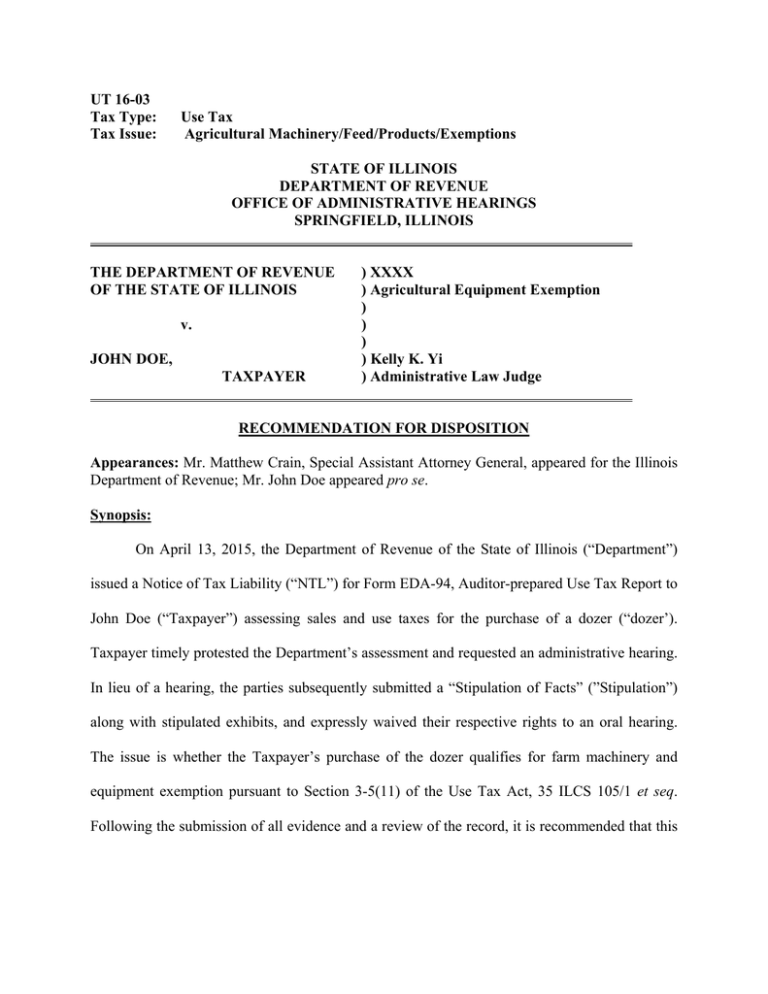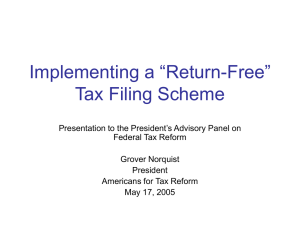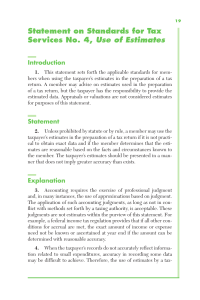UT 16-03 - Illinois Department of Revenue
advertisement

UT 16-03 Tax Type: Tax Issue: Use Tax Agricultural Machinery/Feed/Products/Exemptions STATE OF ILLINOIS DEPARTMENT OF REVENUE OFFICE OF ADMINISTRATIVE HEARINGS SPRINGFIELD, ILLINOIS THE DEPARTMENT OF REVENUE OF THE STATE OF ILLINOIS v. JOHN DOE, TAXPAYER ) XXXX ) Agricultural Equipment Exemption ) ) ) ) Kelly K. Yi ) Administrative Law Judge RECOMMENDATION FOR DISPOSITION Appearances: Mr. Matthew Crain, Special Assistant Attorney General, appeared for the Illinois Department of Revenue; Mr. John Doe appeared pro se. Synopsis: On April 13, 2015, the Department of Revenue of the State of Illinois (“Department”) issued a Notice of Tax Liability (“NTL”) for Form EDA-94, Auditor-prepared Use Tax Report to John Doe (“Taxpayer”) assessing sales and use taxes for the purchase of a dozer (“dozer’). Taxpayer timely protested the Department’s assessment and requested an administrative hearing. In lieu of a hearing, the parties subsequently submitted a “Stipulation of Facts” (”Stipulation”) along with stipulated exhibits, and expressly waived their respective rights to an oral hearing. The issue is whether the Taxpayer’s purchase of the dozer qualifies for farm machinery and equipment exemption pursuant to Section 3-5(11) of the Use Tax Act, 35 ILCS 105/1 et seq. Following the submission of all evidence and a review of the record, it is recommended that this matter be resolved in favor of Taxpayer. The following Findings of Fact and Conclusions of Law are made in support of this recommendation. Findings of Stipulated Facts: 1. The Department’s case, inclusive of all jurisdictional elements, is established by the admission into evidence of the Department’s NTL issued to Taxpayer on April 13, 2015. Joint Ex. 1. 2. Taxpayer purchased a dozer on or about May 30, 2013 from January Auction for a purchase price of $XXXX.1 Stip. p. 1. 3. Taxpayer claimed a farm machinery exemption and paid no Illinois sales tax on the purchase. Stip. p. 1. 4. The Department conducted an audit of the purchase and determined that the primary use of the dozer was not production agriculture within the meaning of Illinois law and the Department’s regulations. Stip. p. 1; Joint Ex. 2. 5. On April 13, 2015, the Department issued an NTL for Form EDA-94, Auditor prepared Use Tax Report, in which Taxpayer was assessed $XXXX in audit tax, $XXXX in audit latepayment penalty, and $XXXX in interest for a total amount of $XXXX. Stip. p. 1; Joint Ex. 2. 6. Taxpayer timely protested the NTL, asserting that the dozer was used for production agriculture. Stip. p. 1: Joint Ex. 3. 7. Taxpayer responded to the Department’s farm machinery & equipment questionnaire (Department of Revenue Equipment Activity List) indicating in verbatim a percentage usage for different activities in the following: 1 The stipulated purchase price of $XXXX is the price used in the audit but the sales receipt shows $XXXX as the purchase price. Joint Ex. 2. 10% 30% 30% 20% 10% 100% Maintenance and mowing of government program acreage (FFA set-aside, etc.) Other (must describe): Root rake Other (must describe): Clean up manure Other (must describe): Push brush and tree that fall on already tillable land Other (must describe): Maintain roadways to fields_____________________ Total Stip. p. 2; Joint Ex. 4. 8. Taxpayer indicated on the Department of Revenue Audit Questionnaire as follows: out of XXXX acres Taxpayer owns, corn and soy bean is grown in XXXX acres; the remaining acres consist of hay, pasture, and timber trees; Taxpayer raises cow-calf pairs; and derives a majority of its income from farming. Stip. p. 2; Joint Exs. 3-4. Conclusions of Law: Under the Use Tax Act (“Act”), Illinois imposes a tax upon the privilege of using in Illinois tangible personal property purchased at retail from a retailer. 35 ILCS 105/3. The use tax is a corollary to the retailers’ occupation tax (“ROT”), which is a tax on persons engaged in the business of selling at retail tangible personal property. 35 ILCS 120/2. The use tax is imposed at the same rate as the ROT. 35 ILCS 105/3-10; 120/2-10. The purpose of the use tax is to prevent avoidance of the ROT by people who make purchases in states that do not impose the ROT and to protect Illinois merchants from the diversion of business to retailers outside Illinois. Brown’s Furniture, Inc. v. Wagner, 171 Ill.2d 410, 418 (1996). If the person who uses the property does not pay the use tax to the retailer, it must be paid directly to the Department. 35 ILCS 105/3-45. Section 12 of the Use Tax Act, 35 ILCS 105/12, incorporates by reference Section 5 of the Retailers’ Occupation Tax Act (“ROTA”), 35 ILCS 120/1 et seq., which provides that if the taxpayer fails to file a return, the Department shall determine the amount of tax due “according to its best judgment and information.” 35 ILCS 105/12; 35 ILCS 120/5. A certified copy of the Department’s determination of the amount of tax due “shall, without further proof, be admitted into evidence…and shall be prima facie proof of the correctness of the amount of tax due, as shown therein.” Id. Once the Department has established its prima facie case by submitting the certified copy of the Department’s determination into evidence, the burden shifts to the taxpayer to overcome this presumption of validity. Clark Oil & Refining Corp. v. Johnson, 154 Ill.App.3d 773, 783 (1stDist. 1987). To prove his case, a taxpayer must present more than testimony denying the Department’s assessment. Sprague v. Johnson, 195 Ill.App.3d 798, 804 (4th Dist. 1990). The taxpayer must present sufficient documentary evidence to support his claim. Id.; Balla v. Department of Revenue, 96 Ill.App.3d 293, 295 (1st Dist. 1981). It is well settled that tax exemption provisions are strictly construed in favor of taxation. Heller v. Fergus Ford, Inc., 59 Ill.2d 576, 579 (1975). The party claiming the exemption has the burden of clearly proving that he is entitled to the exemption and all doubts are resolved in favor of taxation. Id. Section 3-5 of the Use Tax Act provides a list of items that are exempt from the use tax and provides, in relevant part, as follows: Sec. 3-5. Exemptions. Use of the following tangible personal property is exempt from the tax imposed by this Act: *** (11) Farm machinery and equipment, both new and used, including that manufactured on special order, certified by the purchaser to be used primarily for production agriculture or State or federal agricultural programs.*** Farm machinery and equipment shall include precision farming equipment that is installed or purchased to be installed on farm machinery and equipment including, but not limited to, tractors, harvesters, sprayers, planters seeders or spreaders.*** 35 ILCS 105/3-5 (11). Section 3-35 of the Act defines “production agriculture” as follows: Sec. 3-35. Production agriculture. For purposes of this Act, “production agriculture” means the raising of or the propagation of livestock; crops for sale for human consumption; crops for livestock consumption; and production seed stock grown for the propagation of feed grains and the husbandry of animals or for the purpose of providing a food product, including the husbandry of blood stock as a main source of providing a food product. “Production agriculture” also means animal husbandry, floriculture, aquaculture, horticulture and viticulture. 35 ILCS 105/3-35. The Illinois General Assembly authorized the Department to make, promulgate, and enforce reasonable rules and regulations relating to the administration and enforcement of the provisions of the UTA and ROTA. 35 ILCS 105/12; 35 ILCS 120/12. Pursuant to that authority, the Department has adopted a regulation defining “production agriculture,” in relevant part, as follows: Production Agriculture is the raising of or the propagation of: Livestock, crops for sale for human consumption; crops for livestock consumption; and production seed stock grown for the propagation of feed grains and the husbandry of animals or, for the purpose of providing a food product, including the husbandry of blood stock as a main source of providing a food product. Production Agriculture also includes animal husbandry, floriculture, aquaculture, horticulture and viticulture. (Section 2-35 of the Act) (Italics omitted). 86 Ill.Admin.Code §130.305(b). Production Agriculture, with respect to crops, is limited to activities necessary in tilling the soil, planting, irrigating, cultivating, applying herbicide, insecticide or fertilizer, harvesting and drying of crops.***Activities such as the clearing of land, mowing of fence rows, creation of ponds or drainage facilities are not included, nor are the operations involved in the storing or transporting of crops and produce.***With respect to the raising of or propagation of livestock and husbandry of animals, the animals must be domestic farm animals raised for profit. The raising of wild animals, game birds and house pets would not be considered to be production agriculture. (emphasis added). 86 Ill.Admin.Code §130.305(f). Section 130.305(k) of the Department regulation defines “equipment” and its use, in relevant part, as follows: Equipment means any independent device or apparatus separate from any machinery, but essential to production agriculture. ***Equipment used in farm management such as radios and office equipment, in repair and servicing of equipment, in security and fire protection, is not farm equipment; nor does the exemption apply to equipment used in farm maintenance, administration, selling, marketing or the exhibition of products. The exemption does include hand-operated equipment such as wheelbarrows, hoes, rakes, pitchforks and shovels so long as they are used in production agriculture as that term is defined in subsection (b) of this Section.*** (emphasis added). 86 Ill.Admin.Code §130.305(k). The Department has defined the statutory phrase “production agriculture” by expressly including and excluding a class of activities from exemption. 86 Ill.Admin.Code § 130.305(f); Mid-American Growers at 605-06 (citing the definition of production agriculture in 86 Ill.Admin.Code §130.305(f)). With respect to crops, “[a]ctivities necessary in tilling the soil, planting, irrigating, cultivating, applying herbicide, insecticide or fertilizer, harvesting and drying of crops” are expressly included in the exemption. 86 Ill.Admin.Code § 130.305(f). Conversely, “[a]ctivities such as the clearing of land, mowing of fence rows…” are expressly excluded from exemption under the regulation. Id. The Department argues that the dozer is used primarily for activities expressly excluded from exemption under the Department regulations 86 Ill.Admin.Code 130.305(f) & (k). Taxpayer counters that the dozer is primarily used to prepare the soil for planting and to clean up manure in animal husbandry and fertilizing, which both qualify as production agriculture under 86 Ill.Admin.Code 130.305(b) & (f). Taxpayer points out that the root rake is expressly exempt from taxation but is useless without a dozer to run it, arguing that the dozer’s use with the root rake 30% of the time must necessarily be exempt as well. Taxpayer is correct that rakes are expressly exempt from taxation as farm equipment but only hand-operated rakes are exempt in the definition of “equipment.” 86 Ill.Admin.Code §130.305(k). As such, Taxpayer’s argument is without merit. However, the activities necessary in tilling the soil are expressly exempted as production agriculture under 86 Ill.Admin.Code §130.305(f). In support of its claim, Taxpayer presented Farm Service Agency (FSA) maps of its farmland and photographs of timber trees surrounding a vast majority of its tillable acres and explained as follows: “This agriculture activity is to till the ground before planting on the tillable acres bordering any timber to break up the soil and any roots in my tillable ground. As noted in my exhibit on the FSA maps, the blue line represents tillable ground bordered by timber. This is an alternative to using a mow board plow or chisel plow for tilling soil to reduce soil erosion as a soil conservation method.” Taxpayer’s Brief, p. 3. With presentation of such evidence, the burden then shifted to the Department to rebut Taxpayer’s evidence in this regard but it did not present additional evidence. I find that the 30% of the dozer’s use with the root rake qualifies as “production agriculture” under 86 Ill.Admin.Code §130.305(f). With respect to 30% of the use of the dozer to clean up cattle manure in the feed lot, Taxpayer claims that it is an activity necessary in fertilizing and animal husbandry, which are both exempted from use tax as “production agriculture” under 86 Ill.Admin.Code §130.305(b) & (f). The Department contests that the same activity constitutes “farm maintenance,” and is expressly excluded from exemption under 86 Ill. Admin. Code §130.305(k). I agree with Taxpayer that the clean-up of manure in the “raising of livestock” or “animal husbandry” qualifies as production agriculture. However, if the stipulated facts had shown that the dozer was used in general farm maintenance unrelated to production agriculture, that use would not qualify for exemption. With respect to the raising of livestock and husbandry of animals, the regulation states that “the animals must be domestic farm animals raised for profit.” 86 Ill.Admin.Code §130.305(f). Taxpayer has met this requirement as the evidence shows that Taxpayer raises cattle and derives a majority of its income from farming. Joint Ex. 4. I find that 30% of the dozer’s use to clean up cattle manure in the raising of livestock qualifies as “production agriculture.” Taxpayer next claims that 10% of the use to maintain set-aside land as mandated by the United States Department of Agriculture (“USDA”) qualifies for exemption. Joint Ex. 4. While the evidence shows that Taxpayer’s farmland is designated as highly erodible or wetland and is enrolled in the USDA’s Conservation Reserve Program, Taxpayer failed to show specific uses for that purpose such as grading to prevent erosion. See Joint Ex. 3; Taxpayer’s Ex. 1; Taxpayer’s Brief, pp. 1-2. I, therefore, conclude that 10% of the use does not qualify for exemption under 35 ILCS 105/3-5 (11). The remaining 30% of the use is not exempt under the Department’s regulations. The activity of clearing of fallen trees and brush, assigned to 20% of use, is expressly excluded from exemption under the “clearing of land” language in 86 Ill.Admin.Code §130.305(f). The “clearing of land” is a general and expansive phrase, inclusive of all objects removed in clearing of the land. There is no qualifier in the Department regulation to except or limit the definition of “clearing of land.” As to the activities to build and maintain lanes and roadways to farm fields, assigned to 10% of use, Taxpayer admits that such use is not exempt. Taxpayer’s Brief, p. 3. A thorough review of the evidence demonstrates that the dozer is used primarily, 60% of the time, for production agriculture, thus, exempt from taxation under the Use Tax Act. 35 ILCS 105/3-5 (11); 35 ILCS 105/3-35. Recommendation: For the foregoing reasons, I recommend that the Director rescind the Notice of Tax Liability issued to Taxpayer on the purchase of the dozer at issue. December 17, 2015 Kelly K. Yi Administrative Law Judge




